Lancia Thesis 2007 Owner handbook (in English)
Manufacturer: LANCIA, Model Year: 2007, Model line: Thesis, Model: Lancia Thesis 2007Pages: 386, PDF Size: 8.69 MB
Page 261 of 386
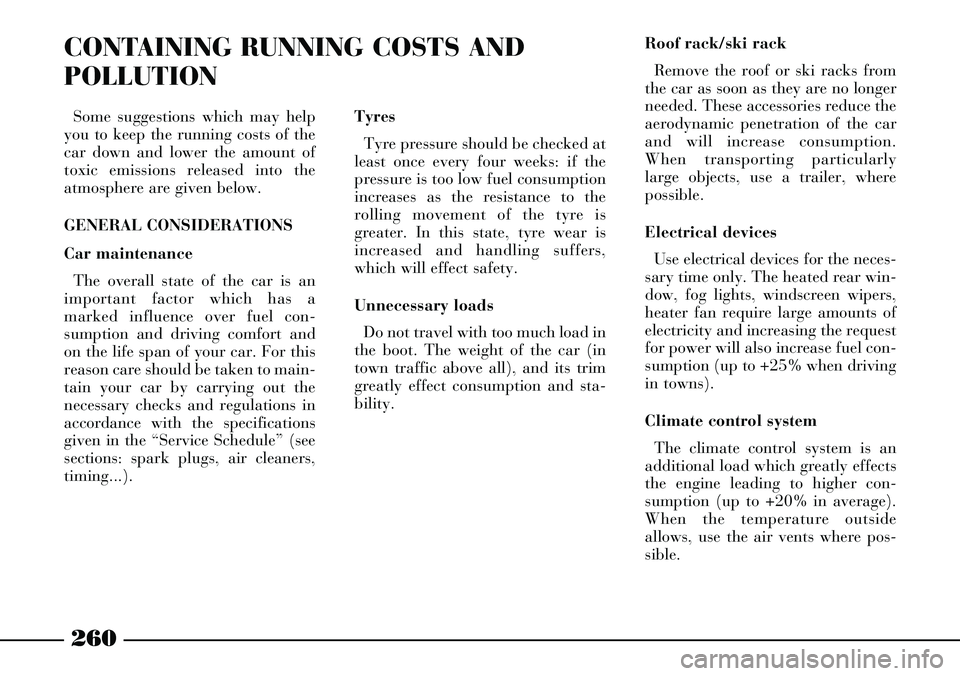
260
CONTAINING RUNNING COSTS AND
POLLUTION
Some suggestions which may help
you to keep the running costs of the
car down and lower the amount of
toxic emissions released into the
atmosphere are given below.
GENERAL CONSIDERATIONS
Car maintenance
The overall state of the car is an
important factor which has a
marked influence over fuel con-
sumption and driving comfort and
on the life span of your car. For this
reason care should be taken to main-
tain your car by carrying out the
necessary checks and regulations in
accordance with the specifications
given in the “Service Schedule” (see
sections: spark plugs, air cleaners,
timing...).Tyres
Tyre pressure should be checked at
least once every four weeks: if the
pressure is too low fuel consumption
increases as the resistance to the
rolling movement of the tyre is
greater. In this state, tyre wear is
increased and handling suffers,
which will effect safety.
Unnecessary loads
Do not travel with too much load in
the boot. The weight of the car (in
town traffic above all), and its trim
greatly effect consumption and sta-
bility.Roof rack/ski rack
Remove the roof or ski racks from
the car as soon as they are no longer
needed. These accessories reduce the
aerodynamic penetration of the car
and will increase consumption.
When transporting particularly
large objects, use a trailer, where
possible.
Electrical devices
Use electrical devices for the neces-
sary time only. The heated rear win-
dow, fog lights, windscreen wipers,
heater fan require large amounts of
electricity and increasing the request
for power will also increase fuel con-
sumption (up to +25% when driving
in towns).
Climate control system
The climate control system is an
additional load which greatly effects
the engine leading to higher con-
sumption (up to +20% in average).
When the temperature outside
allows, use the air vents where pos-
sible.
Page 262 of 386
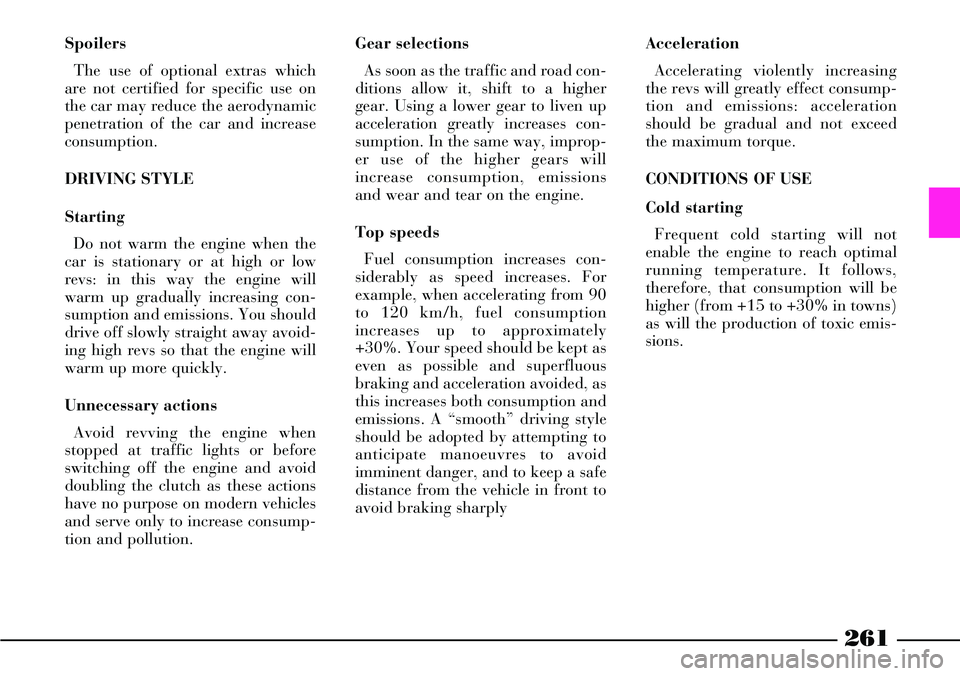
261
Gear selections
As soon as the traffic and road con-
ditions allow it, shift to a higher
gear. Using a lower gear to liven up
acceleration greatly increases con-
sumption. In the same way, improp-
er use of the higher gears will
increase consumption, emissions
and wear and tear on the engine.
Top speeds
Fuel consumption increases con-
siderably as speed increases. For
example, when accelerating from 90
to 120 km/h, fuel consumption
increases up to approximately
+30%. Your speed should be kept as
even as possible and superfluous
braking and acceleration avoided, as
this increases both consumption and
emissions. A “smooth” driving style
should be adopted by attempting to
anticipate manoeuvres to avoid
imminent danger, and to keep a safe
distance from the vehicle in front to
avoid braking sharplyAcceleration
Accelerating violently increasing
the revs will greatly effect consump-
tion and emissions: acceleration
should be gradual and not exceed
the maximum torque.
CONDITIONS OF USE
Cold starting
Frequent cold starting will not
enable the engine to reach optimal
running temperature. It follows,
therefore, that consumption will be
higher (from +15 to +30% in towns)
as will the production of toxic emis-
sions. Spoilers
The use of optional extras which
are not certified for specific use on
the car may reduce the aerodynamic
penetration of the car and increase
consumption.
DRIVING STYLE
Starting
Do not warm the engine when the
car is stationary or at high or low
revs: in this way the engine will
warm up gradually increasing con-
sumption and emissions. You should
drive off slowly straight away avoid-
ing high revs so that the engine will
warm up more quickly.
Unnecessary actions
Avoid revving the engine when
stopped at traffic lights or before
switching off the engine and avoid
doubling the clutch as these actions
have no purpose on modern vehicles
and serve only to increase consump-
tion and pollution.
Page 263 of 386

262
Traffic and road conditions
Heavy traffic and higher consump-
tion are synonymous, for example
when driving slowly with frequent
use of lower gears or in towns where
there are numerous traffic lights.
Winding roads, mountain roads
and bumpy roads also have a nega-
tive effect on consumption.
Enforced halts
During prolonged stops (level
crossings, etc.) the engine should be
switched off.Environmental protection has been
one of the guiding principles in the
production of the THESIS.
It is not accident that its pollution
control equipment is much more
effective than that required by cur-
rent legislation.
Nonetheless, the environment can-
not get by without a concerted effort
from everyone.
By following a few simple rules you
can avoid harming the environment
and often cut down fuel consump-
tion at the same time. On this sub-
ject, a few useful tips have been
given below to supplement those
marked by symbol #, at various
points of the handbook.
You are asked to read both the for-
mer and the latter carefully.CHEAP RUNNING THAT RESPECTS THE
ENVIRONMENT
LOOKING AFTER EMISSION
CONTROL DEVICES
The correct use of pollution control
devices not only ensures respect for
the environment but also has an
effect on the car’s performance.
Keeping these devices in good condi-
tion is therefore a fundamental rule
for driving that is easy on your
pocket and on the environment too.
The first step is to follow the
“Service Schedule” to the letter.
Only use unleaded petrol for petrol
engines (95 RON), for JTD versions
only diesel fuel (EN590 specifica-
tion).
Page 264 of 386

263
Ignoring the above rules
may lead to fire. When functioning nor-
mally, the catalytic con-
verter reaches high tem-
peratures. For this reason, do not
park the car over inflammable
material (grass, dry leaves, pine
needles, etc.): fire hazard.
Do not allow anything to
be sprayed onto the cat-
alytic converter, lambda
sensor and exhaust pipe. Do not install other heat
shields and do not remove
those already fitted to the
catalytic converter and exhaust
pipe. Never run the engine with the
spark plugs disconnected even for
testing purposes. Do not warm up
the engine by letting it idle for a
while before moving off unless the
outside temperature is very low and,
even in this case, only do so for less
than 30 seconds.
If you have trouble starting, do not
keep turning the ignition key for
long periods. Be especially careful to
avoid bump starting the car by
pushing, towing or rolling downhill:
these are all manoeuvres that can
damage the catalytic exhaust sys-
tem. Use an auxiliary battery for
start-ups only.
If the engine begins to “lose its
smoothness” when travelling, con-
tinue your journey but reduce the
demands you are making on the
engine and have the car seen at a
Lancia Dealershipas soon as you
can.
When the instrument panel fuel
reserve warning light comes on, fill
up as soon as possible. A low level of
fuel can cause an uneven supply of
fuel to the engine with the inevitable
increase in the temperature of the
exhaust gas and serious damages to
the catalytic converter.
Page 265 of 386
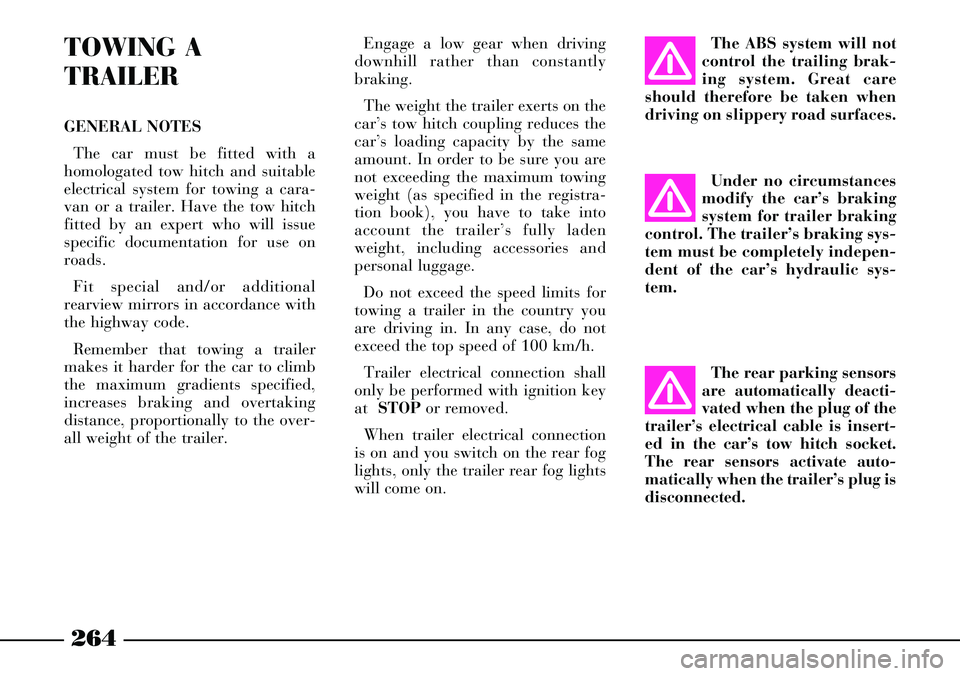
264
TOWING A
TRAILER
GENERAL NOTES
The car must be fitted with a
homologated tow hitch and suitable
electrical system for towing a cara-
van or a trailer. Have the tow hitch
fitted by an expert who will issue
specific documentation for use on
roads.
Fit special and/or additional
rearview mirrors in accordance with
the highway code.
Remember that towing a trailer
makes it harder for the car to climb
the maximum gradients specified,
increases braking and overtaking
distance, proportionally to the over-
all weight of the trailer.Engage a low gear when driving
downhill rather than constantly
braking.
The weight the trailer exerts on the
car’s tow hitch coupling reduces the
car’s loading capacity by the same
amount. In order to be sure you are
not exceeding the maximum towing
weight (as specified in the registra-
tion book), you have to take into
account the trailer’s fully laden
weight, including accessories and
personal luggage.
Do not exceed the speed limits for
towing a trailer in the country you
are driving in. In any case, do not
exceed the top speed of 100 km/h.
Trailer electrical connection shall
only be performed with ignition key
at STOPor removed.
When trailer electrical connection
is on and you switch on the rear fog
lights, only the trailer rear fog lights
will come on.The ABS system will not
control the trailing brak-
ing system. Great care
should therefore be taken when
driving on slippery road surfaces.
Under no circumstances
modify the car’s braking
system for trailer braking
control. The trailer’s braking sys-
tem must be completely indepen-
dent of the car’s hydraulic sys-
tem.
The rear parking sensors
are automatically deacti-
vated when the plug of the
trailer’s electrical cable is insert-
ed in the car’s tow hitch socket.
The rear sensors activate auto-
matically when the trailer’s plug is
disconnected.
Page 266 of 386

265
TOW HITCH INSTALLATION
The tow hitch must be fixed to the
body by an expert in accordance
with the following instructions and
respecting the additional and/or
integrative information provided by
the tow hitch manufacturer.
The tow hitch to be fitted must
comply with the current regulations
in force, with reference to Directive
94/20/EEC and subsequent modifi-
cations.
Use a tow hitch suited for the max-
imum towable load of the car ver-
sion on which the tow hitch is to be
fitted.
Use a unified coupling for the elec-
trical connections. The coupling is
generally fitted on a specific mount
fastened to the tow hitch. A specific
trailer lights control unit shall be
installed on the car.For the electric connections, a 7
pole 12VDC coupling must be used
(CUNA/UNI and ISO/DIN stan-
dards). Follow the instructions pro-
vided by the manufacturer of the car
and/or the tow hitch.
The electrical brake (where rele-
vant) or other device (electrical
winch, etc.) must be powered direct-
ly from the battery by means of a
lead with a cross-section area no
smaller than 2.5 mm
2.
IMPORTANTUse the electrical
brake or winch only when the engine
is running.
In addition to the electrical connec-
tions, only the power wire for an
additional electrical brake and for
internal trailer lighting with a power
not exceeding 15W can be connect-
ed to the car’s electrical system.
For connections use the specific
control unit with battery cable not
less than 2.5 mm
2.INSTALLATION DIAGRAM (fig. 1)
Fasten the tow hitch in the points
marked with (1) using 18 M10
screws and, in the points marked
with (2) use four M8 screws.
Fasten the tow hitch to the body
avoiding any type of drilling and
trimming of the rear bumpers that
remains visible when the tow hitch is
removed.
IMPORTANTFasten a tag in a
clearly visible position at the same
height as the tow hitch. The tag is
compulsory. It must be adequately
sized, made of suitable material and
carry the following information:
MAX LOAD ON BALL COUPLING
75 kg.
After assembly, seal the fastening
screws holes to prevent exhaust fumes
from entering the passenger compart-
ment.
Page 267 of 386

266
fig. 1L0A0264b
Page 268 of 386

267
WINTER TYRES
These tyres have been specifically
designed for use on snow and ice
and should be fitted in place of the
existing tyres.
Use only the homologated tyres
listed in log book.
Lancia Dealershipswill be glad
to provide advice on the most suit-
able type of tyres according to your
needs.
For information on the tyres to be
fitted, inflation pressure and winter
tyre specifications, follow the pre-
scriptions given in “Technical speci-
fications”.
The performance of winter tyres is
greatly reduced when the tread
depth is less than 4mm. In this situ-
ation it would be safer to have them
replaced.Due to winter tyre features, under
normal conditions of use or on long
motorway journeys, the perfor-
mance of these tyres is lower than
that of standard tyres.
The use of these tyres should there-
fore be limited to the conditions for
which they were designed and certi-
fied.
IMPORTANT When using winter
tyres with a maximum speed index
below the one that can be reached
by the car (increased by 5%), place
a suitable notice in the passenger
compartment to inform the driver of
the top speed at which the winter
tyre can run (as per EC Directive).All four tyres should be the same
(brand and track), to ensure greater
safety when driving, braking and
cornering.
Remember that it is inappropriate
to change the direction of rotation of
tyres.
The maximum speed for winter
tyres with “Q” marking is 160
km/h, with “T” marking is 190
km/h, whereas with “H” marking is
210 km/h. Always respect the high-
way code speed limit.
Page 269 of 386
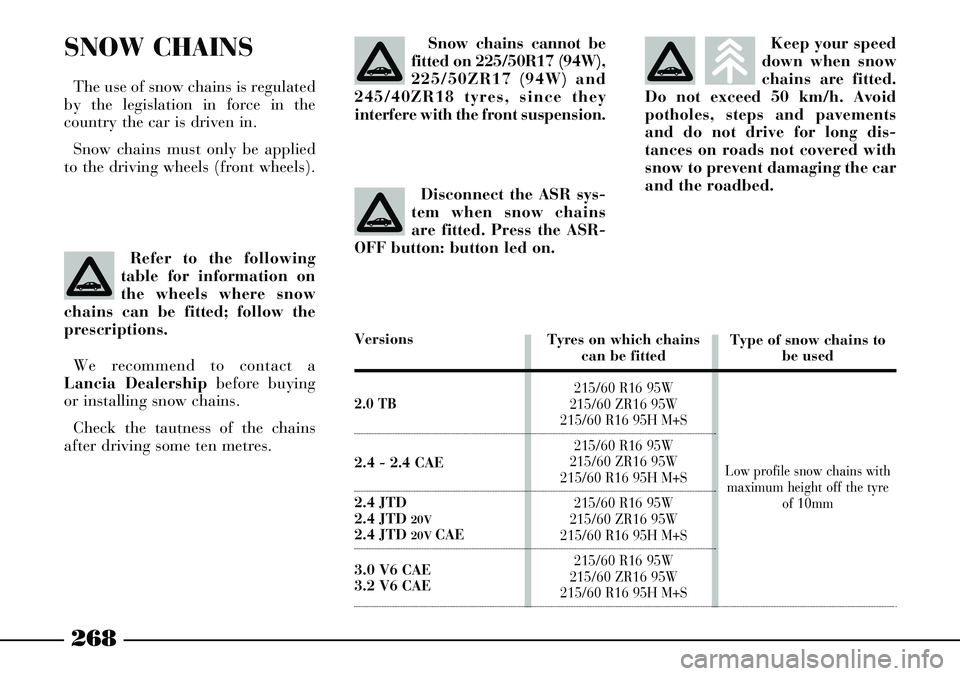
268
Snow chains cannot be
fitted on 225/50R17 (94W),
225/50ZR17 (94W) and
245/40ZR18 tyres, since they
interfere with the front suspension.Keep your speed
down when snow
chains are fitted.
Do not exceed 50 km/h. Avoid
potholes, steps and pavements
and do not drive for long dis-
tances on roads not covered with
snow to prevent damaging the car
and the roadbed.
Disconnect the ASR sys-
tem when snow chains
are fitted. Press the ASR-
OFF button: button led on.
SNOW CHAINS
The use of snow chains is regulated
by the legislation in force in the
country the car is driven in.
Snow chains must only be applied
to the driving wheels (front wheels).
Versions
2.0 TB
2.4 - 2.4 CAE
2.4 JTD
2.4 JTD 20V2.4 JTD 20V CAE
3.0 V6 CAE
3.2 V6 CAE
Refer to the following
table for information on
the wheels where snow
chains can be fitted; follow the
prescriptions.
We recommend to contact a
Lancia Dealershipbefore buying
or installing snow chains.
Check the tautness of the chains
after driving some ten metres.
Tyres on which chains
can be fitted
215/60 R16 95W
215/60 ZR16 95W
215/60 R16 95H M+S
215/60 R16 95W
215/60 ZR16 95W
215/60 R16 95H M+S
215/60 R16 95W
215/60 ZR16 95W
215/60 R16 95H M+S
215/60 R16 95W
215/60 ZR16 95W
215/60 R16 95H M+S
Type of snow chains to
be used
Low profile snow chains with
maximum height off the tyre
of 10mm
Page 270 of 386
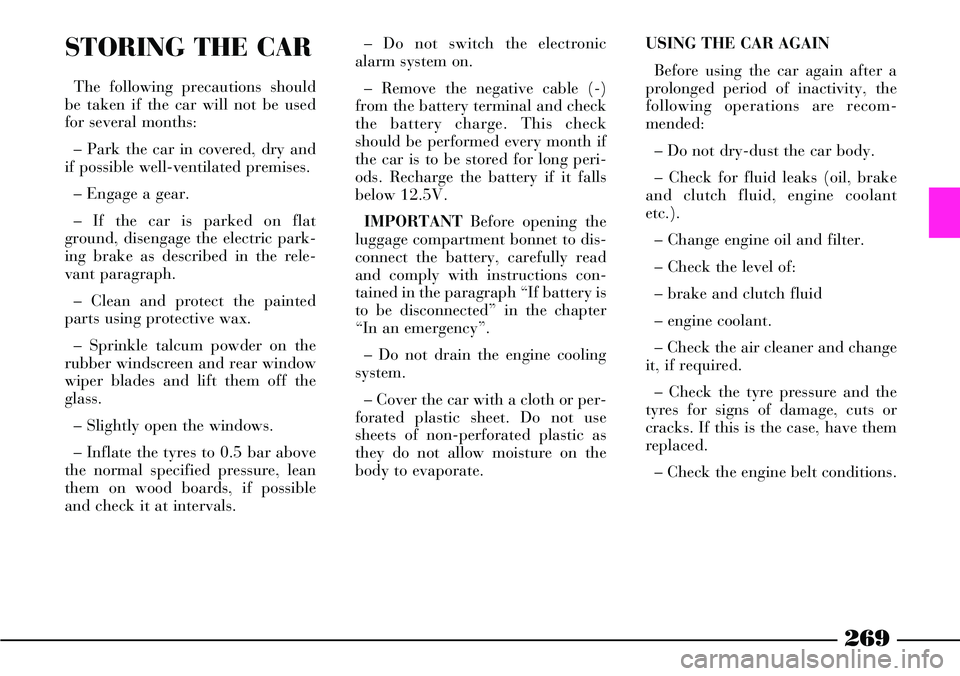
269
USING THE CAR AGAIN
Before using the car again after a
prolonged period of inactivity, the
following operations are recom-
mended:
– Do not dry-dust the car body.
– Check for fluid leaks (oil, brake
and clutch fluid, engine coolant
etc.).
– Change engine oil and filter.
– Check the level of:
– brake and clutch fluid
– engine coolant.
– Check the air cleaner and change
it, if required.
– Check the tyre pressure and the
tyres for signs of damage, cuts or
cracks. If this is the case, have them
replaced.
– Check the engine belt conditions.STORING THE CAR
The following precautions should
be taken if the car will not be used
for several months:
– Park the car in covered, dry and
if possible well-ventilated premises.
– Engage a gear.
– If the car is parked on flat
ground, disengage the electric park-
ing brake as described in the rele-
vant paragraph.
– Clean and protect the painted
parts using protective wax.
– Sprinkle talcum powder on the
rubber windscreen and rear window
wiper blades and lift them off the
glass.
– Slightly open the windows.
– Inflate the tyres to 0.5 bar above
the normal specified pressure, lean
them on wood boards, if possible
and check it at intervals.– Do not switch the electronic
alarm system on.
– Remove the negative cable (-)
from the battery terminal and check
the battery charge. This check
should be performed every month if
the car is to be stored for long peri-
ods. Recharge the battery if it falls
below 12.5V.
IMPORTANT Before opening the
luggage compartment bonnet to dis-
connect the battery, carefully read
and comply with instructions con-
tained in the paragraph “If battery is
to be disconnected” in the chapter
“In an emergency”.
– Do not drain the engine cooling
system.
– Cover the car with a cloth or per-
forated plastic sheet. Do not use
sheets of non-perforated plastic as
they do not allow moisture on the
body to evaporate.